![]()
Fingers and Thumbs – You Can Do It Acupressure
Hippocrates, the father of modern therapeutic science, is believed to have said: ‘It is nature that heals, not the physician.’ For centuries people believed that there was a Vital Force, or regulatory agency, in the body that protected it against disease or brought about healing. Naturopaths also believed that ‘it is the body that acts upon the drugs, and not the drugs upon the body’.
In modern Western medicine, our approach is predominantly minimalistic and focuses so much on the minute parts of an individual that in the process we lose sight of the whole. In the words of Dr William Gutman of New York Medical School: ‘This system treats each symptom in isolation, prescribing analgesics for pain, antipyretics for fever, laxatives for constipation, etc.’
In contrast to this, Traditional Chinese Medicine (TCM) – along with many other centuries-old systems of medicine like Ayurveda and homeopathy – adopts a more holistic approach. Acupuncture is a 3,500-year-old component of TCM that is based on the principle that ‘Qi’ (pronounced chee), or energy, flows throughout the body along specific pathways. These pathways are commonly known as ‘meridians’.
Over hundreds of years practitioners have located and mapped certain external pressure points along these meridians, which are referred to as ‘acupoints’. By stimulating these acupoints one can regulate ‘Qi’. It is also believed that disease or illness is a consequence of the imbalance or disturbance in Qi. The food we eat, the air we breathe, the oxygen content of the air and air pollution can all affect the quality of Qi.
Acupuncture professes that this energy flow can be improved and balanced by the insertion of very fine metallic needles into these specific points on the meridians. The fundamental promise of acupuncture is that it is possible to heal the body by using its own natural healing mechanism.
Using the same principle, you can stimulate the flow of Qi by applying pressure at the acupoints using just your fingers and thumbs, a technique known as acupressure. According to the Sushrut Samhita, an ancient Sanskrit text on medicine, acupressure therapy was popular in India 5,000 years ago. It then spread to Sri Lanka and from there, Buddhist monks took it to China, where it was further developed as acupuncture.
But why should you bother with acupressure when there are so many drugs available to help heal your pet, among them NSAIDs, steroids and opiates? Well, as I explain in Chapter 8: Which Drugs and Why, all drugs have side effects. In elderly animals, those with other concurrent illnesses or those who have chronic disease, you can reduce the use of these drugs by using acupressure or acupuncture. They are another tool in your tool box, and they are free from side effects, safe and holistic.
Both acupuncture and acupressure are accepted by the Royal College of Veterinary Surgeons (RCVS) and the American Veterinary Medical Association (AVMA). There is good, solid science behind them, and a lot of evidence showing that they work. Moreover, they can beautifully complement and integrate with conventional medicine. In one episode of the recently broadcast BBC series Trust Me, I’m A Doctor, acupuncture was tested and proven to work.
Like many practitioners, I too believe that by sending our own loving Qi through our fingertips into our pets we can further enhance the acupressure treatment. In the UK, and in most other countries, acupuncture using needles can only be practised by a qualified veterinarian, but acupressure can be used by you to heal your pet.
Acupressure can relieve many painful conditions (see A–Z Common Conditions chapter), prevent illness and quicken your pet’s recovery. Research has shown that stimulation of acupressure points releases endorphins, which relieve pain. Moreover, I have seen it work, and so have people all over the world.
Acupressure points (or acupoints) are identified by one or more letters and numbers. Going into more detail is beyond the scope of this book, but simply put, the letters are an abbreviation for the organ that rules the particular meridian. For example, ST stands for stomach meridian and BL for bladder meridian. There are 12 major meridians and if we connect the dots of the acupuncture points on the body’s surface, we will end up following each of these 12 channels or pathways.
Every time I show a pet guardian the acupoints on their pet’s body, they ask, ‘What if I press the wrong acupoint?’ But there is no need to worry or panic about doing this, because it is not dangerous to press on any other point. You may not be solving the current issue, but no harm will be done. So if you are unsure, even pressing near the correct acupoint will help.
However, there are certain situations in which you should avoid giving acupressure to your pet, and these are given below:
First of all, choose the perfect location for your acupressure session. This place should be peaceful, have minimal distractions and most importantly, be somewhere your pet feels safe and relaxed. Read Chapter 5: How To Give Healing To Your Pet, and follow the procedure described in ‘preparing for a healing session’: this is really important.
The next step is to prepare yourself to give acupressure. As Elizabeth explains in Chapter 5, being calm, present, grounded and relaxed is essential for successful healing. If you or your pet are anxious or stressed, any treatment is unlikely to work. I have always grounded and calmed myself before giving acupuncture or acupressure.
Please note that as with healing, acupressure should not be forced on your pet. If your pet walks away, respect that. You must be patient and willing to wait and observe for signs or signals from your pet that indicate permission. For example, your pet may sit close to you, nudge your hand, lick your hand or even lie down quietly beside you. Once you are both settled, you can start the assessment process to ascertain problem areas:
Start your session with an opening massage. Use your fingers or thumbs, or the heel of your hand (whichever is easy for you), and feel free to gently squeeze the muscles – provided your pet is okay with it.
Start at the base of the skull, with your hands on either side of the head, then travel down the spine, working your way to the base of the tail. Do this twice. During the third time, start from the skull base as before, but stop where the ribs end and follow the ribs round until both your hands meet underneath the belly.
Now you are ready to focus on the acupoints. You can work on as many or as few points as your pet will permit. There are acupressure point charts available which show all the points one can use for a particular condition or illness (see the further reading section for books and other sources).
You can follow these charts and stimulate every point depicted in them, or just pick the points detailed under the individual conditions listed in Chapter 7: A–Z Common Conditions in Cats and Dogs, and in the ‘acupoints for beginners’ list below.
Finish the session with a closing massage, repeating the procedure described for the opening massage: the only difference is in your intention. You can make a silent wish that your gift of acupressure should be beneficial to your pet and help him heal. As massage ensures a good flow of Qi, you can use this massage technique weekly or even daily, as it is a useful way of balancing Qi and therefore preventing illness.
Many experts believe that the secret to a good massage lies in the application of even pressure, rather than the intensity. So please listen to your pet and pay attention to their response. If they seem to be uncomfortable, you may be applying too much pressure. Stroking their neck and ears can help calm them. Try massaging the Bai hui or GV 20 (see below), as this can also help relax your pet if they are agitated.
You can use Elizabeth’s rosemary massage oil on your fingertips to enhance a treatment, especially for pain relief. Remember that excess fat on your pet’s body will inhibit the flow of Qi so you may need to apply a bit more pressure or give more than two treatments per day for ailments.
Finally, after a treatment, do avoid sudden temperature changes, hectic exercise or feeding – at least for an hour. The frequency of treatments will depend on the circumstances. It is sensible to allow a gap of 3–5 days between full acupressure sessions so that your pet can adjust to the energy changes.
You can do the treatments twice daily if necessary for specific ailments. A wellness or maintenance treatment to ensure healthy Qi flow can be given weekly. There are wellness charts with acupoints in the books listed in the further reading section at the back of the book.
I have listed below some important and easy-to-locate acupoints that you can use when your pet exhibits the particular symptom or condition mentioned under each point. Two important emergency acupoints and eight easy-to-use ones are described here, and the accompanying illustrations show me pointing to these points on dear Morris (Elizabeth’s pet), who was very cooperative.
You can familiarize yourself with these acupoints to start with. If you find them effective, and your pet is cooperative, you can buy the books recommended in the further reading section and try more points. There are also acupressure courses available, which you can take if you wish to raise your knowledge to the next level. See Resources section for details.
Please note that what follows is not a sequence of points; instead, each point helps with a specific problem.
Emergency point in heart attack or breath-holding. GV 26 or ‘Governing Vessel 26’ is located at the centre, just below the nose and above the upper lip. If your pet ever stops breathing or is in shock and unconscious, you need to jab repeatedly at this point with the tip of a pen, your fingernail or a needle. Usually this will get your pet breathing. I have often used it in anaesthetized animals, who can sometimes breath-hold, and it worked every time. DO NOT try this on a conscious animal – you will get bitten!
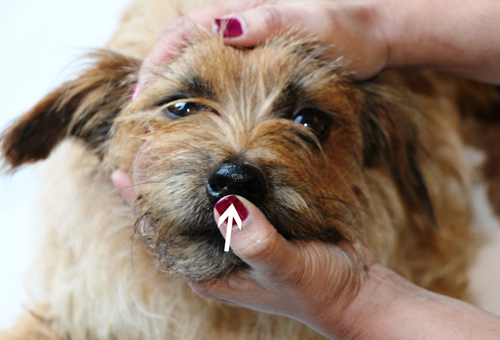
Emergency point for asthma or wheezing – especially in cats. ‘Lung 7’ is located immediately above the wrist bone in a tiny depression on the inside aspect of the front paw. By just massaging this point, it is possible to help your pet breathe more easily and prevent an asthma attack. Of course, if their breathing is severely laboured, you must make sure they are seen by a vet and use appropriate prescribed drugs. However, if you are stuck or there is a delay before you can get to the vet, this could be very useful.

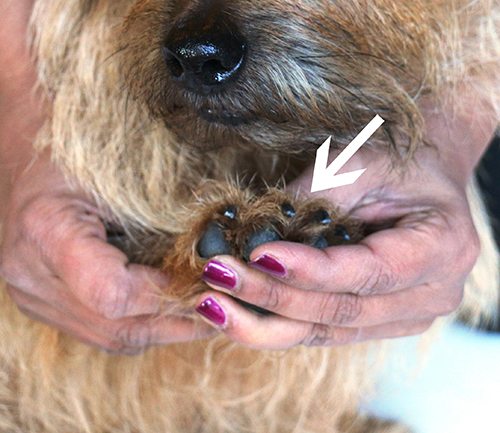
Aspirin point – useful point for pain relief. ‘Bladder 60’ is located on the outside of the back (or hind) leg, in the Achilles depression behind the leg bone (above the calcaneous), where it meets with the ankle. When your pet is in pain, applying constant pressure for 1–2 minutes on this point twice daily can help relieve it.
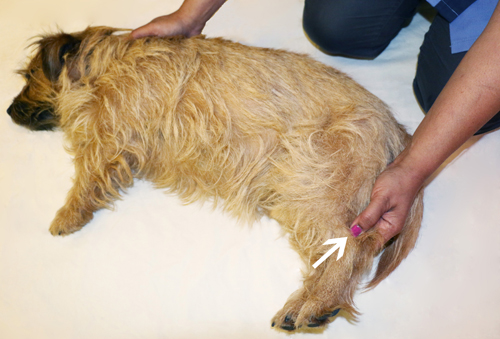
Bai Hui – Hundred convergences. ‘Governing Vessel 20’ is known as the point of hundred convergences, or summit of the bodily mountain. It is located pretty much at the top of the head, or the crown, in a depression that is in line with the ears. In dogs and cats it is also the name for the acupoint in the dip between the spinal vertebrae on the back, where there is a flat area between the hips.
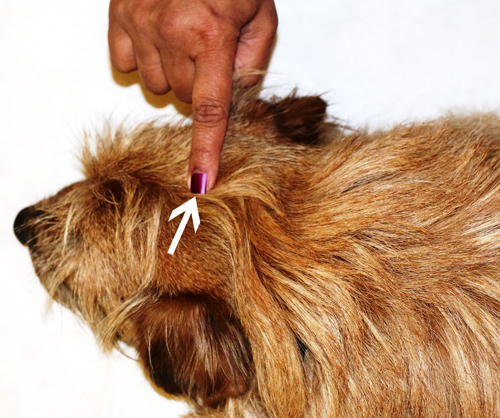
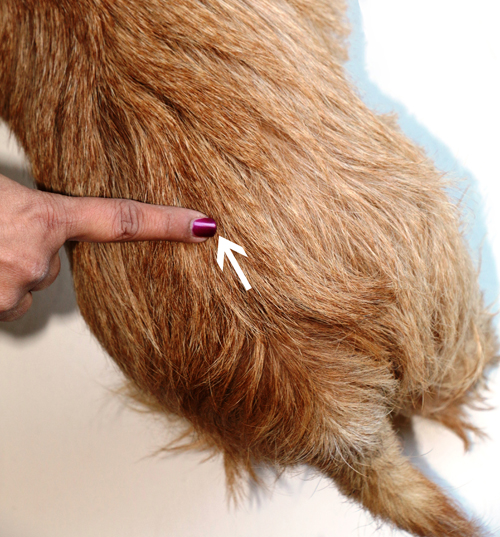
It is considered a traditional point for animals and is beneficial for balancing liver Qi and stabilizing or calming the emotions. Most pets love being massaged at this point, with either the thumb or two fingers. GV 24 is another point that is located on the head, along the central line, but more in line with the back of the eye; this can be massaged in epileptics and in those with emotional disorders.

Powerful point for energizing and enhancing. ‘Stomach 36’ is located behind or lateral to the tibial crest, on the outer aspect of the back leg, just below the knee in a depression where the lower leg (tibia) joins the knee. Stimulating this point can help with stomach or gastrointestinal upset. ST 36 is known to relieve exhaustion and it energizes a tired dog so much that he can walk a further 3 miles (5km) – which is why it is known as the ‘three mile point’. It can also help improve the appetite if your pet is anorexic.
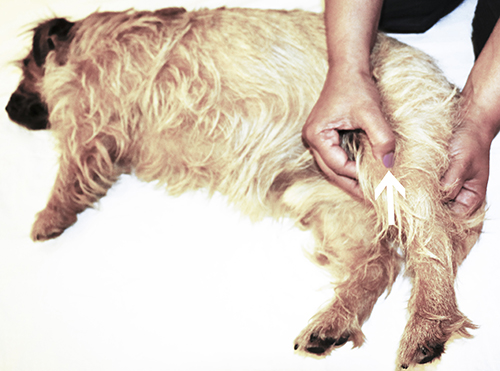
Longevity point for maintaining good health. ‘Large Intestine 4’ is located on the front paw, in the depression of the dewclaw webbing, or where the thumb and forefinger meet. Massaging it increases protective Qi circulation and can contribute to a long, healthy life.
It is also useful for reducing aggression and for relieving allergies, aching neck, shoulder pain, a blocked nose or even sinus problems. Take care with this point as not all pets like their feet being touched. Morris is quite hairy, so in the photograph I have just pointed to the location of the point.

Local neck and ear point. ‘Bladder 10’ is located below and behind the ear, between the first and second cervical vertebrae, just off the centre of the spine. There is one on either side, bilaterally symmetrical, so you can stimulate them simultaneously. Most pets love having these points massaged. This massage can help with ear disorders like smelly ears, otitis and ear infections. It can also relieve neck pain.
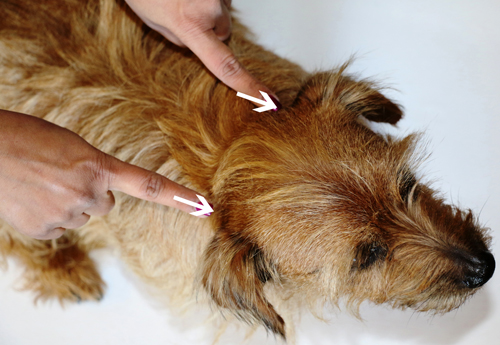
Key heart point. ‘Heart 7’ or ‘Spirit is Door’ is located on the outer aspect of the front leg, at the wrist, in a triangular depression formed by the tendon and the wrist bone. After flexing the wrist gently while lifting the paw, you may massage this point in a circular fashion for a couple of minutes. This helps reduce heart palpitations and stabilizes the emotions. Cats have a natural instinct to lick themselves here while grooming, which may be calming to them.

Hip triangle. ‘Bladder 54’ is located in front of the femur, or thigh bone, below the hip joint; ‘Gall Bladder 29’ is located on the hip bone, in front of the hip joint; and ‘Gall Bladder 30’ is located on the back side of the pelvis, below and also behind the hip joint.
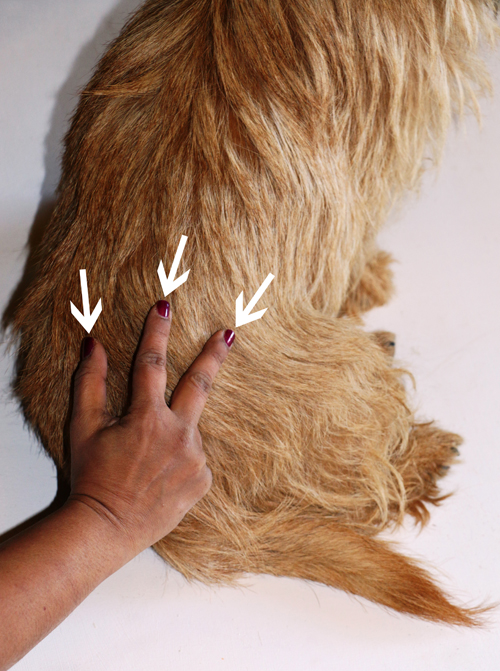
By making a three-finger tripod using the thumb, index finger and middle finger, where the index finger is at the top of the bone and the thumb and middle fingers on either side, you can gently apply pressure for about a minute to relieve any pain in the hip joint and the area around it. It is very useful in dogs with hip dysplasia or arthritis of the hip.
Balance points for organs in the chest. ‘Urinary Bladder (BL) 13, 14 and 15’ are located on either side of the spine, starting from the shoulder blades, and then the 3rd, 4th and 5th intercostals or rib spaces. They help balance energy in the lungs and the heart and can also help relax the diaphragm. Massaging them in a back-and-forth motion for a couple of minutes is beneficial for restoring proper balance.
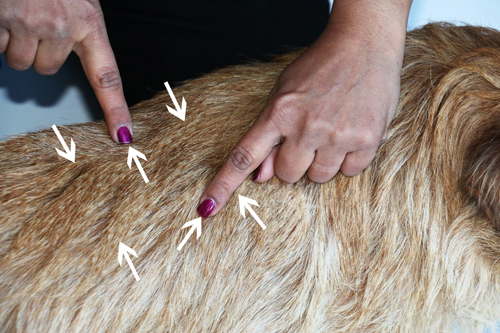
Unlike many other complementary modalities – including acupuncture, where you may cause damage if you have no training – acupressure is quite forgiving. So go ahead and try it. Here is a useful checklist to remind you of the key points and get you started.
Remember: acupressure is a very useful tool, available at the tips of your fingers, but it is not a substitute for veterinary care, so please use it as a complement rather than an alternative.